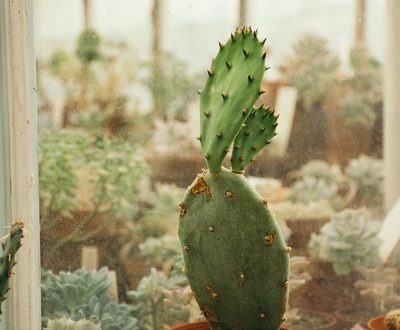 Think of plants you’d rather not handle, and cacti are the first to come to mind. However, not only do we have to manipulate these spiny specimens from time to time, but a whole range of other ‘ouchy’ garden plants sooner or later require our attention.
Think of plants you’d rather not handle, and cacti are the first to come to mind. However, not only do we have to manipulate these spiny specimens from time to time, but a whole range of other ‘ouchy’ garden plants sooner or later require our attention.
Any gardener who has ever dug sheep manure into their edible beds knows that stinging nettles and thistles are the price they pay for their natural fertilizer. Rose gardeners face the prickles too, as do those who enjoy Bougainvillea, pyrocantha, holly, argave, and a range of other succulents. We do battle with prickles every time we harvest our gooseberries, and if you’re the proud owner of the prolifically-fruiting Worcesterberry, you’ll know just how much like tacks its barbs really are. Even our beloved natives like to taunt us with their prickles. Our gloriously sculptural Aciphylla (commonly known as ‘spear grass’), and matagouri make garden statements like no other but it pays to keep well back from them. And pretty, feathery toi toil is no fun at all when you attempt to cut back its sharp-edged foliage.
If you don’t want to end up in your doctor’s waiting room, it pays to use a range of tricks to help you avoid the ouchies. Stout prickle- and cut-proof gloves are a good start but your arms can also do with a cover-up. While it’s possible to purchase commercial gardening arm protection, you can also make your own by cutting the arms from op-shop coats made from heavy-duty prickle-proof fabric. Simply stitch or glue on Velcro straps to tighten both ends around your arms and wrists. In fact, many jackets will already have a fastener on the cuff. Not confident with a needle and thread? No problem! The answer is to source an old wetsuit from a charity shop and snip off the arms or legs to the required length. Pull these ‘sleeves’ over your arms for instant protection.
Sometimes, gloves just and sleeves aren’t enough, especially when we have to handle small prickly plants – or pieces of them. The secret when repotting the likes of smaller cacti is to use kitchen tongs to separate, pick up and plant. Handy with the chopsticks? These are another household tool that lend themselves to handling smaller prickly plants. If you’re packaging pieces of cacti or prickly plant to give to a friend, capture them inside a tube made of several layers of newspaper taped together to form a roll. Once the piece is inside, fold over the ends and seal with more tape.
When replanting a seriously heavy piece of prickly plant (and some juice-heavy succulents can be weighty), cut down a thick cardboard carton, fold it over to create two flaps, and sandwich the spiny piece between the layers as you manipulate it. Old carpet can also be a boon when used in the same way, with the advantage that the plant’s prickles adhere to the ‘fluffy’ side of the carpet, which helps hold the piece in place as you shift it.
While gardeners usually take care of their hands and arms, a common injury from prickly and cutting plants, is to the feet. Just when you are congratulating yourself on a job well done, you fail to notice that sections of ouchy plant have been left behind on the ground. Not only can these cause injuries when the plant is fresh, but as it dries, its spines, thorns or sharp edges become even harder, and can damage a foot as well as a blade or an upturned nail. When you’ve finished your Ouchy gardening, check the garden and paths carefully, and remove any debris with a fork or long-handled tongs (barbeque tongs are ideal for this). Enjoy your garden, but stay safe!










Join the Discussion
Type out your comment here:
You must be logged in to post a comment.